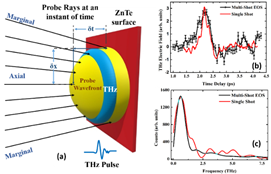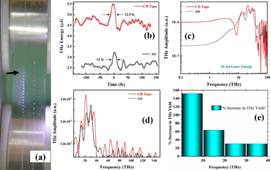|
Study on THz generation in ultrashort laser produced air plasma and its characterization
In recent times, there has been a surge in activity in the frequency domain, lying between far infrared (FIR) and micro-wave region, conventionally called as “Terahertz (THz)” region, owing to its unique characteristics. Apart from being non-ionizing in nature, this frequency range (typically 0.1 – 10 THz) contains the “signatures” of various organic and semiconductor materials which makes this very useful for various fields of research and applications such as homeland security, pharmaceutical industries, quality inspection in semi-conductor industries, art work restoration and many more. Moreover, use of THz frequencies in conjunction with other frequencies (UV/VIS/NIR/MIR), time resolved information about materials can be obtained.
The THz generation mechanisms known so far, can be broadly classified in two categories: (1) electronic approach and (2) photonics approach. Till date the 1st approach, though vary successful and highly reproducible, mostly focussed in 0.1 – 1 THz regime. However, the 2nd approach provides several mechanisms which can produce THz with frequency content more than this range (e.g., optical rectification of inorganic and organic crystals). However, of all the approaches, laser produced plasma in ambient air stands out as a source of intense, ultra-broadband source of THz radiation.
When two-colour (typically, fundamental and its second harmonic) femtosecond laser pulses are co-focussed in ambient air with a relative phase difference of “π/2”, the resultant asymmetric electric field leads to net non-zero transient current which radiates broadband THz radiation while oscillating across its mean position. The amplitude and frequency content of the resultant THz radiation depends of the rate of change of this transient current density. Therefore, shorter duration laser pulses yield higher THz flux with respect to relatively longer duration laser pulses.
The characterization of THz radiation is, most commonly, performed with Electro-Optic Sampling (EOS) technique. In this technique, the passage of THz radiation through a non-linear crystal (e.g., ZnTe, GaP etc.) results in change of polarizability and is thus probed by another femtosecond (typically, small part of main THz producing laser pulse) laser pulse. Evidently, the scheme requires long scanning time and thus inherently slow in nature. However, there are applications which demands rapid characterization of THz radiation, in such cases methods based on single-shot acquisitions are preferred. Though there are several ways to perform such single-shot measurements, we have demonstrated a simple yet very powerful method which offers high signal-to-noise ratio among all.

Fig. 1: (a) Schematic principle of THz detection using curve wavefront. (b) Comparison of THz waveform obtained from multi-shot scanning method and single-shot method. (c) Corresponding THz frequency spectra obtained by performing Fourier Transform of the waveforms recorded in (b).
The principle of the detection scheme is shown in figure 1(a) below. We have used the curvature of the probe beam to sample the entire THz radiation and thus able to obtain the temporal waveform of THz in a single-shot. Figure 1(b), shows the comparison of THz temporal waveform obtained with both multi-shot scanning and single-shot based methods. It is evident that the single-shot method faithfully represents the THz waveform obtained by the multi-shot scanning methods. The corresponding frequency spectra for the both the waveforms are displayed in figure 1(c).
Though, EOS is the most commonly used technique for THz characterization, however, it suffers from the disadvantage of limited THz bandwidth detection owing to phononic absorption of the crystal materials. Therefore, other detection methodologies have to be devised for this purpose. Fourier Transform spectrometry (FTS) is one such technique which is known for quite extensively used in infrared spectroscopy and is devoid of such bandwidth limitations. We have developed a FT spectrometer in-house to characterize the broadband THz radiation produced by two-color femtosecond laser pulses.
As mentioned earlier, the THz production by two-color femtosecond laser pulse relies on the rate of change of transient current density. Therefore, increase of current density by means of larger number of electronic charges will definitely yield higher THz radiation. Keeping this in mind, we have introduced, a transparent glue-less commercially available tape target in the air plasma produced by two-color laser pulses.

Fig. 2: (a) Laser created damaged spots on the tape target as indicated by the horizontal black arrow. (b) THz waveforms recorded with and without the tape target in ambient air using Fourier Transform spectrometry. Corresponding frequency content of both the waveforms are shown with ‘frequency’ axis in (c) ‘logarithmic’ scale and (d) in ‘linear’ scale to highlight the low and high frequency sides. (e) Relative enhancement (in “%”) in THz yield recorded with Tape target over the entire frequency range is displayed.
The position of the tape target was scanned across the plasma filament formed in ambient air and optimized for highest THz yield. Figure 2(a) displays the plasma spot created by the two-color laser pulse on the tape surface. The tape was continuously moved in order to ensure that each time the laser pulses face a fresh spot. The in-house developed FT spectrometer has been used to characterize the THz radiation produced by the air plasma along and with the inclusion of tape target. Figure 2(b) displays the THz waveform recorded by the FT spectrometer with and without the tape target. Corresponding frequency spectra are shown in figure 2(c) and 2(d) with the frequency axis in logarithmic” and “linear” scale respectively to highlight the lower and higher end of the frequency spectra. The relative enhancement (in “%”) of THz flux across the frequency spectra (up to 40 THz) with the inclusion of tape target is displayed in figure 2(e). Evidently, inclusion of tape target in air plasma yields 150 % increase in THz radiation in the 0.1 – 10 THz range. Even for the higher frequency ranges, the inclusion of tape target yields higher THz flux. The observations vindicate the initial hypothesis that increase of transient current (though locally, in case of tape target) substantially increases the THz yield.
For more detail please see the publications appearing on the website.
|
















